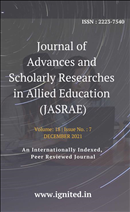A Study on Bioactivity in Indian Water Toxins of Certain Coniids
Exploring the Bioactivity and Pharmacological Potential of Indian Water Toxins from Conus Species
Keywords:
DEAE Cellulose, anion exchange Chromatography, crude protein concentration, Conus species, NaCl, venom, brain, heart, renal, liver, tissue histology examinations, analgesic test, albino mice, tail-flick technique, snails, cones, biology, feeding habits, Venom's role, marine pharmacology, conotoxin targetsAbstract
DEAE Cellulose anion exchange Chromatography collected the crude protein concentration of three Conus species, employing a 0.1-1.0 M NaCl step-by-step gradient and 10 fraction each of 15 mL, F1-F10. The crude venom in Conus inscriptus, two Conus lentiginosus fractions, and one in Conus zeylanicus at a concentration of 0.1 mL was shown to be fatal in four fractions. The brain, heart, renal and liver has been thoroughly removed and tissue histology examinations have been conducted. Analgesic test on albino mice indicated an analgesic effect using the tail-flick technique. As the study discussing snails, cones, analgesics, biology and feeding habits in the human history, Venom’s role, marine pharmacology, conotoxin targetsPublished
2019-05-01
How to Cite
[1]
“A Study on Bioactivity in Indian Water Toxins of Certain Coniids: Exploring the Bioactivity and Pharmacological Potential of Indian Water Toxins from Conus Species”, JASRAE, vol. 16, no. 7, pp. 200–205, May 2019, Accessed: Jul. 05, 2024. [Online]. Available: https://ignited.in/jasrae/article/view/12033
Issue
Section
Articles
How to Cite
[1]
“A Study on Bioactivity in Indian Water Toxins of Certain Coniids: Exploring the Bioactivity and Pharmacological Potential of Indian Water Toxins from Conus Species”, JASRAE, vol. 16, no. 7, pp. 200–205, May 2019, Accessed: Jul. 05, 2024. [Online]. Available: https://ignited.in/jasrae/article/view/12033








